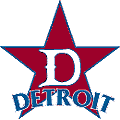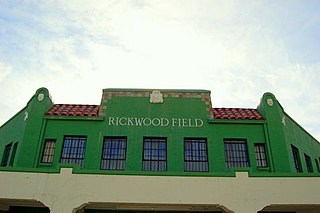Related Research Articles

Tiger Stadium, previously known as Navin Field and Briggs Stadium, was a multi-use stadium located in the Corktown neighborhood of Detroit. The stadium was nicknamed "The Corner" for its location at the intersection of Michigan and Trumbull Avenues. It hosted the Detroit Tigers of Major League Baseball (MLB) from 1912 to 1999, as well as the Detroit Lions of the National Football League (NFL) from 1938 to 1974. Tiger Stadium was declared a State of Michigan Historic Site in 1975 and has been listed on the National Register of Historic Places since 1989.

Shibe Park, known later as Connie Mack Stadium, was a ballpark located in Philadelphia. It was the home of the Philadelphia Athletics of the American League (AL) and the Philadelphia Phillies of the National League (NL). When it opened April 12, 1909, it became baseball's first steel-and-concrete stadium. In different eras it was home to "The $100,000 Infield", "The Whiz Kids", and "The 1964 Phold". The venue's two home teams won both the first and last games at the stadium: the Athletics beat the Boston Red Sox 8–1 on opening day 1909, while the Phillies beat the Montreal Expos 2–1 on October 1, 1970, in the park's final contest.

Mack Fletcher Jones, nicknamed "Mack The Knife", was an American Major League Baseball left fielder who played for the Milwaukee / Atlanta Braves (1961–1967), Cincinnati Reds (1968), and Montreal Expos (1969–1971). He batted left-handed, threw right-handed and was listed as 6 feet 1 inch (1.85 m) tall and 180 pounds (82 kg).

Bennett Park was a ballpark in Detroit. Located at Michigan and Trumbull Avenues, it was home to the Detroit Tigers and was named after Charlie Bennett, a former player whose career ended after a train accident in 1894.

The Detroit Stars were an American baseball team in the Negro leagues and played at historic Mack Park. The Stars had winning seasons every year but two, but were never able to secure any championships. Among their best players was Baseball Hall of Famer Turkey Stearnes.

Rickwood Field, located in Birmingham, Alabama, is the oldest professional baseball park in the United States. It was built for the Birmingham Barons in 1910 by industrialist and team-owner Rick Woodward and has served as the home park for the Birmingham Barons and the Birmingham Black Barons of the Negro leagues. Though the Barons moved their home games to the Hoover Met in the suburbs, and most recently to Regions Field in Birmingham, Rickwood Field has been preserved and is undergoing gradual restoration as a "working museum" where baseball's history can be experienced. The Barons also play one regular season game a year at Rickwood Field. Rickwood Field is listed on the National Register of Historic Places.
Boundary Field, also known as American League Park II and National Park, is a former baseball ground in Washington, D.C. located on the site currently occupied by Howard University Hospital; bounded approximately by Georgia Avenue, 5th Street, W Street and Florida Avenue, NW. It was just outside what was then the city limit of Washington, whose northern boundary was Boundary Street which was renamed Florida Avenue in 1890.

Clearwater Athletic Field was a stadium in Clearwater, Florida. It was first used by professional baseball teams for spring training in 1923 and was the Phillies' first spring training ballpark in Clearwater. The grandstand sat approximately 2,000 and bleachers increased capacity to close to 3,000. Home plate was located on Pennsylvania Avenue, which ran south to north along the third base line, near Seminole Street. Left field ran parallel to Palmetto Street, and right field ran parallel to Greenwood Ave. The grandstand was destroyed by fire in April 1956.

Hamtramck Stadium, also known as Roesink Stadium is one of only 12 remaining Negro league baseball stadiums. It is located at 3201 Dan Street, in Veterans Park, in Hamtramck, Michigan. The stadium was listed on the National Register of Historic Places in 2012. The stadium is located near, and occasionally confused with, Keyworth Stadium. The stadium was rededicated on June 20, 2022, as part of the Juneteenth celebration. In 2020, the stadium's field was renamed Norman "Turkey" Stearnes Field, after Detroit Stars player Turkey Stearnes.
The 1925 Detroit Stars baseball team competed in the Negro National League during the 1925 baseball season. The team compiled a 56–44 record (.560) in games against National League opponents. The Stars played their home games at Mack Park located on the east side of Detroit, about four miles from downtown, at the southeast corner of Fairview Ave. and Mack Ave. The team was owned by John A. Roesink and managed on the field by catcher-manager Bruce Petway.
The 1930 Detroit Stars baseball team competed in the Negro National League during the 1930 baseball season. The team compiled a 54–41 record, had a 24-game winning streak in July and August, won the league's second-half championship, and lost to the St. Louis Stars in a postseason series billed as the "Negro World Series".
The 1923 Detroit Stars baseball team competed in the Negro National League (NNL) during the 1923 baseball season. The Stars compiled a 41–30 overall record (.577) and 39–27 against NNL opponents. They finished in third place in the NNL.
The 1920 Detroit Stars baseball team competed in the Negro National League (NNL) during the 1920 baseball season. The Stars compiled a 37–27 record (.578) and finished in second place in the NNL behind the Chicago American Giants.
The 1921 Detroit Stars baseball team competed in the Negro National League (NNL) during the 1921 baseball season. The Stars compiled a 38–46–1 record (.453) and finished fifth in the NNL.
The 1924 Detroit Stars baseball team competed in the Negro National League (NNL) during the 1923 baseball season. The Stars compiled a 35–31–1 record (.530) and finished third in the NNL.
The 1926 Detroit Stars baseball team competed in the Negro National League (NNL) during the 1926 baseball season. The team compiled a 52–47–1 record (.525) and finished fourth in the NNL. The Stars played their home games at Mack Park located on the east side of Detroit, about four miles from downtown, at the southeast corner of Fairview Ave. and Mack Ave. The team was owned by John A. Roesink and managed by Bill Riggins and Candy Jim Taylor.
The 1927 Detroit Stars baseball team competed in the Negro National League (NNL) during the 1927 baseball season. The team compiled a 52–47 record (.525) and finished fifth in the NNL. The Stars played their home games at Mack Park located on the east side of Detroit, about four miles from downtown, at the southeast corner of Fairview Ave. and Mack Ave. The team was owned by John A. Roesink and managed by Bingo DeMoss.
The 1929 Detroit Stars baseball team competed in the Negro National League (NNL) during the 1929 baseball season. The team compiled a 44–45 record (.494) and finished fifth in the NNL. The Stars played their home games at Mack Park located on the east side of Detroit, about four miles from downtown, at the southeast corner of Fairview Ave. and Mack Ave. The team was owned by John A. Roesink and managed by Bingo DeMoss.
The 1931 Detroit Stars baseball team competed in the Negro National League (NNL) during the 1931 baseball season. The team compiled a 25–33 record (.431) and finished fourth in the NNL. The Stars played their home games at Mack Park located on the east side of Detroit, about four miles from downtown, at the southeast corner of Fairview Ave. and Mack Ave. The team was owned by John A. Roesink and managed by Bingo DeMoss.
References
- ↑ The day the Tigers finally integrated by Vivian M. Baulch and Patricia Zacharias, The Detroit News. Retrieved 2010-03-17.
- ↑ Baseball Book Excerpts | BaseballLibrary.com Archived 2006-08-25 at the Wayback Machine . Retrieved 2010-03-17.
- ↑ Baseball Book Excerpts | BaseballLibrary.com Archived 2006-08-25 at the Wayback Machine . Retrieved 2010-03-17.
- ↑ Mack Park. Retrieved 2010-03-17.
- ↑ Baseball Book Excerpts | BaseballLibrary.com Archived 2006-08-25 at the Wayback Machine . Retrieved 2010-03-17.
- ↑ Mack Park/Fairview Homes. Retrieved 2010-03-17.
- ↑ Mack Park/Fairview Homes. Retrieved 2010-03-17.
- ↑ Mack Park/Fairview Homes. Retrieved 2010-03-17.
- ↑ Detroit Stars. Retrieved 2010-03-17.
- ↑ Mack Park/Fairview Homes. Retrieved 2010-03-17.